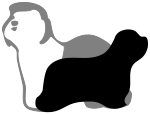Standard
ORIGIN: Great-Britain.
DATE OF PUBLICATION OF THE OFFICIAL VALID STANDARD: 03.11.2014.
UTILIZATION: Sheepdog & companion.
FCI – CLASSIFICATION: Group 1 Sheepdogs and Cattle Dogs (except Swiss Cattle Dogs). Section 1 Sheepdogs.
Without working trial.
BRIEF HISTORICAL SUMMARY: There is mention of a breed resembling the Bearded Collie in Scottish records dating back to around the sixteenth century. He has long been known in Scotland and Northern England where he was bred for herding sheep. Some five hundred years ago dogs, which were also said to be the forerunners of the Polish Lowland Sheepdog were abandoned on the shores of Scotland and these bred with native herding dogs. A look at the Polish Lowland will show similarities. But the Bearded Collie as we know it today owes most of what we have to G Olive Willison who, in the 1940s, came into possession of a Beardie puppy called Jeannie. After searching she found a mate for Jeannie, a dog called Bailey, and her Bothkennar kennels set the mould for today’s Bearded Collies.
GENERAL APPEARANCE: Lean, active dog. Though strongly made, should show plenty of daylight under body and should not look too heavy. Bright, enquiring expression is a distinctive feature.
IMPORTANT PROPORTIONS: Longer than it is high in an approximate proportion of 5 to 4 measured from point of chest to point of buttock. Bitches may be slightly longer. Distance between stop and occiput should be equal to width between orifices of ears.
BEHAVIOUR/TEMPERAMENT: Alert, lively, self-confident and active. Steady, intelligent working dog, with no signs of nervousness or aggression.
HEAD: In proportion to size. Whole effect being that of a dog with strength of muzzle and plenty of brain room.
CRANIAL REGION:
Skull: Broad, flat and square. Stop: Moderate.
FACIAL REGION:
Nose: Large and square, generally black but normally following coat colour in blues and browns. Nose of solid colour without spots or patches.
Muzzle: Strong and equal in length to distance between stop and occiput.
Lips: Of solid colour without spots or patches. Pigmentation follows nose colour.
Jaws/teeth: Teeth large and white. Jaws strong with a perfect, regular and complete scissor bite preferred, i.e. upper teeth closely overlapping lower teeth and set square to the jaws. Level bite tolerated but undesirable.
EYES: Toning with coat colour, set widely apart and large, soft and affectionate, not protruding. Pigmentation of eye rims follows nose colour. Eyebrows arched up and forward but not so long as to obscure eyes.
EARS: Of medium size and drooping. When alert, ears lift at base, level with, but not above top of skull, increasing apparent breadth of skull.
NECK: Moderate length, muscular and slightly arched.
BODY: Length of back comes from length of rib cage and not that of loin.
Back: Level.
Loin: Strong.
Chest: Deep, giving plenty of heart and lung room. Ribs well sprung but not barrelled.
TAIL: Set low, without kink or twist and long enough for end of bone to reach at least point of hock. Carried low with an upward swirl at tip whilst standing or walking, may be extended at speed. Never carried over back. Covered with abundant hair.
LIMBS
FOREQUARTERS:
General appearance: Legs straight and vertical with good bone, covered with shaggy hair all round.
Shoulder: Sloping well back.
Metacarpus (Pastern): Flexible without weakness.
Forefeet: Oval with soles well padded. Toes arched and close together, well covered with hair, including between pads.
HINDQUARTERS:
General appearance: Well muscled.
Stifle (Knee): Well bent
Lower thigh: Good.
Hock joint: Low.
Metatarsus (Rear pastern): Lower leg falls at right angle to ground and, in normal stance, is just behind a line vertically below point of buttock. Hind feet: Oval with soles well padded. Toes arched and close together, well covered with hair, including between pads.
GAIT/MOVEMENT: Supple, smooth and long-reaching, covering ground with minimum of effort.
COAT
Hair: Double with soft, furry and close undercoat. Outer coat flat, harsh, strong and shaggy, free from woolliness and curl, though slight wave permissible.
Length and density of hair sufficient to provide a protective coat and to enhance shape of dog, but not enough to obscure natural lines of body. Coat must not be trimmed in any way. Bridge of nose sparsely covered with hair slightly longer on side just to cover lips. From cheeks, lower lips and under chin, coat increases in length towards chest, forming typical beard.
Colour: Slate grey, reddish-fawn, black, blue, all shades of grey, brown and sandy with or without white markings. Never merle/dapple. When white occurs it appears on foreface, as a blaze on skull, on tip of tail, on chest, legs and feet and, if round the collar, roots of white hair should not extend behind shoulder. White should not appear above hocks on outside of hindlegs. Slight tan markings are acceptable on eyebrows, inside ears, on cheeks, under root of tail and on legs where white joins main colour.
SIZE AND WEIGHT:
Ideal height at withers: Males 53– 56cm.
Females 51–53 cm.
Overall quality and proportions should be considered before size but excessive variations from the ideal height should be discouraged.
FAULTS: Any departure from the foregoing points should be considered a fault and the seriousness with which the fault should be regarded should be in exact proportion to its degree and its effect upon the health and welfare of the dog and its ability to perform its traditional work.
DISQUALIFYING FAULTS :
- Aggressive or overly shy dogs.
- Any dog clearly showing physical or behavioural
N.B.:
- Male animals should have two apparently normal testicles fully descended into the scrotum.
- Only functionally and clinically healthy dogs, with breed typical conformation should be used for breeding.
The latest amendments are in bold characters.
